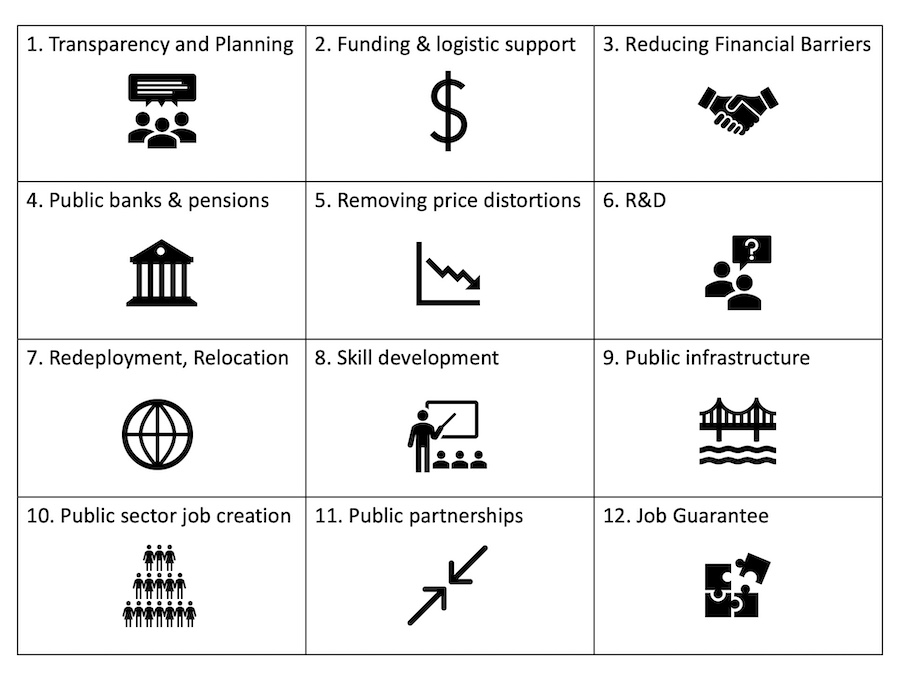4.7 Climate change policy challenges

Study Notes
“The real choice is not jobs or environment. It is both or neither.”
Brian Kohler, Communications, Energy and Paperworkers Union of Canada, December 5, 1996
A green transition requires governments implement a structural program designed to significantly change the patterns of industry output, employment and the consumption patterns of households and firms.
It will have to fundamentally alter the line between government and market responsibility for resource allocation, with the government being at the centre, which is appropriate, because it aligns responsibility for planned action with the currency-issuing capacity.
What has MMT to say about that? Very little. But what it has to say is crucial to the success of the transition.
The standard response to any large-scale policy intervention is: How are we going to pay for it?
An MMT understanding makes it clear that if policy makers become timid because they are trapped into the mainstream thinking that says the government is financially constrained, then the outcomes are likely to be inferior.
An MMT understanding shifts our focus to questions about the resource implications of the required changes in output and consumption patterns, and, how best to ensure the necessary reconfiguration of productive resources is achieved without invoking inflationary pressures.
While it is clear that a currency-issuing government’s spending is not financially constrained, the scale and type of shifts required may necessitate the spending initiatives be supplemented with additional policies to provide spending offsets to ensure the government is not just competing for existing resources with other users at market prices.
For example, some taxation initiatives may be required, not to fund the spending, but, rather, to free up resources to allow the new public spending to be non-inflationary. An MMT understanding allows us to map out appropriate policy combinations without falling into the mainstream trap that fiscal deficits are damaging and need to be avoided.
Nations are at a point in history where there is considerable socio-economic and ecological damage after four decades or so of policies driven by neoliberal market ideology.
Some pundits believe that environmental challenges can be separated out from the socio-economic issues such as rising income inequality, precarious work, elevated levels of unemployment and underemployment, public service retrenchment, public infrastructure degradation. They argue that we can all agree on the climate issues, whereas if the solution is lumped in with policies to address these socio-economic issues, then ideological dissent will likely undermine progress on the climate agenda.
The problem with that approach is summarised by the opening quote.
The Just Transition framework
In the mid-1990s, Canadian trade unionist, Brian Kohler believed that unless environmentalists recognised that support of workers affected by climate initiatives was essential, their agendas would meet with resistance.
He wrote:
… if you attack us in our workplaces, if you fail to understand the jobs issue, you will create a confrontation that you cannot win. You will force us into an alliance with our employers and you, we, society and the environment will all be the losers.
The traditional construction of environment versus jobs was thus self-defeating.
In that regard, his union proposed the “Just Transition Program” to serve as a model for societies that had to:
… make some tough choices about which economic activities we are willing to continue and which we are willing to forego, a structured transition or “just” transition program is necessary, if the costs of those decisions are to be shared fairly. For it is absolutely clear that without such a plan, the people that will pay 99 percent of the price of change will be the workers in the affected industries and the communities that rely on the income of those workers. Capital can write off losses, collect insurance in some cases, and re-invest elsewhere. Workers do not have these kinds of options. Without a “Just Transition Program” you guarantee conflict, and possibly violent conflict.
This is why the environmental agenda must be pursued within a socio-economic agenda.
Brian Kohler outlined the fundamental characteristics of the Just Transition framework:
- “Protect the purchasing power of workers and their families”.
- “Facilitated transition of environmentally displaced workers to new employment”.
- “A redefinition if necessary, of the term employment to reflect the principles of sustainability”.
- “Support for communities dependent on sunset industries”.
Some elements of this framework are mapped out in the following matrix.

You will notice that the Job Guarantee is one essential element in a Just Transition framework. But it should not be the primary job creation focus of governments. The Just Transition framework will require governments create significant numbers of skilled and permanent jobs, which are not suited to a buffer stock status.
The Job Guarantee will supplement the other policies to ensure jobs are always available to the most disadvantaged workers.
